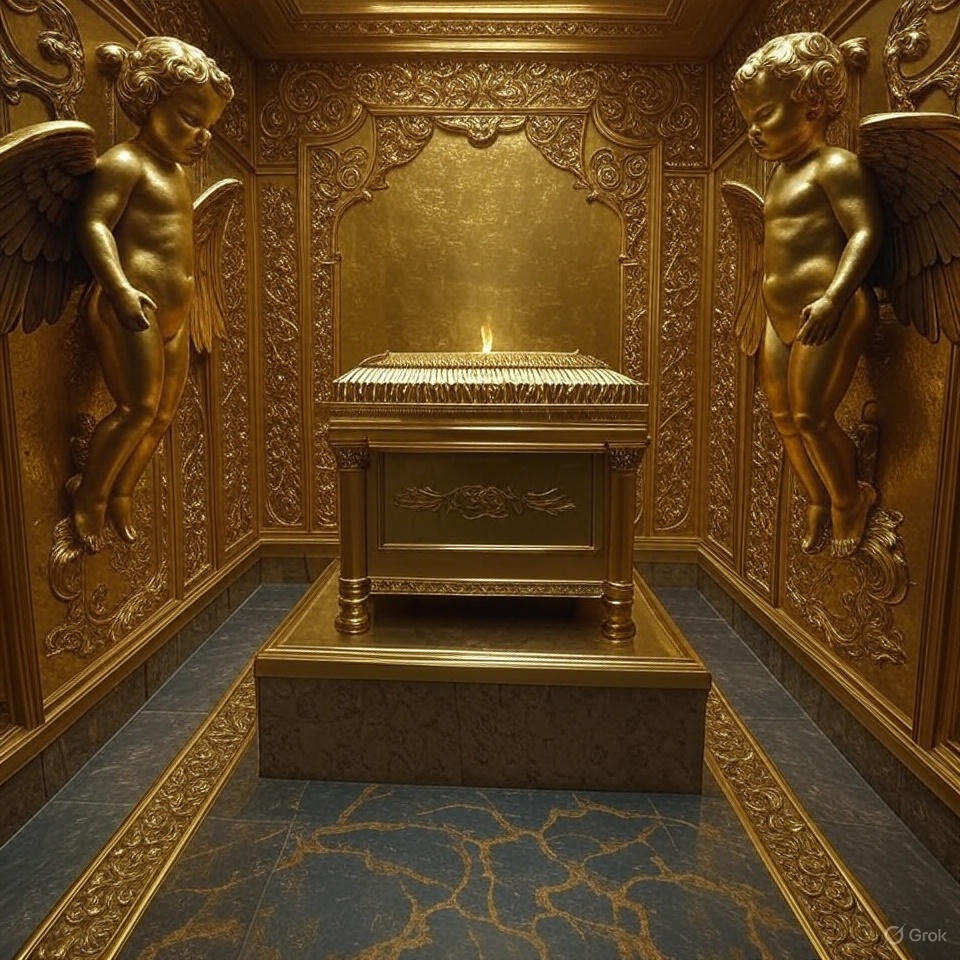Imagine standing amid a sea of humanity, the air thick with the scent of smoldering incense and the low hum of thousands of voices raised in unified awe. The sun hangs low over the Judean hills, casting a golden hue on walls of gleaming cedar and burnished gold. This isn’t a scene from a Hollywood epic—it’s the heart-pounding reality of one of history’s most spectacular moments: the dedication of Solomon’s Temple in ancient Jerusalem. We’re talking about a day in the seventh month of the Hebrew calendar, Ethanim (what we’d call mid-to-late September today), around 959 BCE, when King Solomon, son of David, transformed a dream into a divine dwelling place. This wasn’t just a building project; it was a cosmic handshake between heaven and earth, a event so charged with symbolism and spectacle that its ripples still crash against our modern shores.
Why dive into this ancient spectacle now, in the crisp air of September 2025? Because history isn’t a dusty relic—it’s a living blueprint. The dedication of the Temple wasn’t merely a ribbon-cutting for a fancy sanctuary; it was a masterclass in faith-fueled ambition, communal triumph, and unshakeable divine favor. As we unpack the layers of this event—from the meticulous planning and jaw-dropping architecture to the thunderous prayers and miraculous fire from heaven—we’ll uncover not just what happened, but why it matters. And here’s the fun part: we’ll bridge the millennia with practical takeaways that turn this biblical blockbuster into your personal playbook for building something extraordinary in your life today. Buckle up; this journey through time is equal parts history lesson, adventure tale, and motivational spark.
Let’s start at the beginning, because no great story skips the setup. Solomon’s ascent to the throne in itself reads like a plot twist worthy of a binge-worthy series. David, the shepherd-turned-king whose life was a whirlwind of battles, psalms, and palace intrigue, had long dreamed of building a permanent home for the Ark of the Covenant—the gold-covered chest housing the Ten Commandments, Aaron’s rod, and a pot of manna, a tangible symbol of God’s covenant with Israel. But God had other plans. In 1 Chronicles 22:8, He tells David, “You have shed much blood and have fought many wars. You are not to build a house for my Name, because you have shed much blood on the earth in my sight.” Ouch. So, the task falls to Solomon, whose name means “peace,” a king whose reign was marked by wisdom rather than warfare.
Solomon’s story kicks off with that iconic divine encounter at Gibeon, where God offers him anything he desires. Instead of riches or long life, Solomon asks for wisdom to govern God’s people (1 Kings 3:5-14). Boom—God grants it, plus throws in wealth and honor as a bonus. This sets the stage for the Temple project, announced in 1 Kings 5. Solomon, ever the strategist, forges alliances far and wide. He strikes a deal with Hiram, king of Tyre, a Phoenician powerhouse known for its seafaring prowess and timber trade. Hiram supplies cedar and cypress from Lebanon’s forests, floated down the coast to Joppa, then hauled overland to Jerusalem—a logistical feat that would make modern project managers sweat. In exchange, Solomon sends 20,000 cors of wheat and 20,000 baths of olive oil annually. That’s roughly 125,000 bushels of grain and over 100,000 gallons of oil—enough to fuel a small economy.
But manpower? Solomon doesn’t mess around. He conscripts 30,000 Israelites for logging rotations in Lebanon, 70,000 carriers, 80,000 stonecutters in the hills, and 3,600 overseers (1 Kings 5:13-18). Foreign laborers, including descendants of the Canaanites, join the fray. The workforce swells to over 150,000 souls, toiling under the relentless Levantine sun. Quarries echo with the chisel’s ring as massive limestone blocks—some weighing tons—are dressed with precision, so finely cut that “no hammer, chisel or any other iron tool was heard at the temple site” during assembly (1 Kings 6:7). It’s a hush-hush operation, a testament to ancient engineering smarts that rivaled the pyramids.
Now, the Temple itself—oh, what a marvel. Construction begins in the fourth year of Solomon’s reign, the second month, Ziv (around April/May 966 BCE), and wraps up seven years later in the eighth month, Bul (October/November 959 BCE). But the dedication? That’s the star of the show, slotted for Ethanim, the seventh month, aligning with the Feast of Tabernacles—a harvest festival of joy and gratitude. Why the delay? Scholars suggest it allowed time for final fittings and to sync with the sacred calendar, maximizing spiritual impact.
Step inside this architectural poem. The Temple complex sprawls over a 500-cubit by 300-cubit platform (about 875 by 525 feet), but the heart is the sanctuary: 60 cubits long, 20 wide, 30 high (roughly 105 by 35 by 52 feet). Enter through massive bronze doors overlaid with gold filigree, guarded by cherubim carvings. The Holy Place dazzles with five lampstands of pure gold, a golden incense altar, and the table of showbread—all illuminated by ten golden menorahs. But the inner sanctum, the Most Holy Place, is the knockout punch: a perfect cube, 20 cubits on each side, shrouded in darkness save for the divine presence. Two towering cherubim of olive wood, each 10 cubits high (17.5 feet), wings outstretched to touch at 20 cubits span, flank the Ark. Walls, floors, and ceilings? Clad in gold—over 600 talents (about 23 tons) pounded thin and applied with loving care. Cedar panels carved with gourds, flowers, and palm trees add organic flair, while pomegranates dangle from capitals like festive ornaments.
Fun fact: The stones? Sourced from the royal quarry, cut to such exact specs that they fit without mortar, a dry-stack technique that screams earthquake resistance. And the gold? Likely from Ophir, via Hiram’s Red Sea fleet, traded for exotic goods like apes and peacocks (1 Kings 10:22). Solomon’s not just building a temple; he’s curating a sensory symphony—sights of shimmering metal, smells of myrrh and frankincense, sounds of harps and lyres.
As the dedication day dawns—let’s peg it around September 15-22, 959 BCE, give or take, based on Tishri 8-15—the city pulses with anticipation. Pilgrims flood Jerusalem from Dan to Beersheba, a human tide of over 100,000 strong, if we trust the chronicler’s estimates. The streets, normally a dusty bustle of merchants and shepherds, transform into a carnival of faith. Booths sprout like mushrooms for the Feast of Tabernacles, palm fronds waving like green flags. Sacrificial animals low in pens: 22,000 oxen and 120,000 sheep, a barbecue for the gods on a scale that would bankrupt a small nation today.
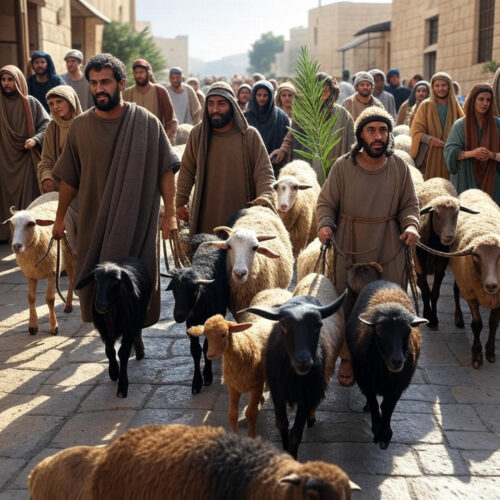
Solomon, resplendent in his kingly robes—perhaps linen shot with gold thread, a crown glinting atop his head—leads the procession. Trumpets blast, a 120-strong priestly choir swells with song: “He is good; his love endures forever” (2 Chronicles 5:13). The Ark, that sacred relic absent a fixed home since the tabernacle days, is borne on poles by Levites, shrouded in blue cloth. No more wandering in tents; this is permanence.
The procession winds up Mount Moriah, site of Abraham’s near-sacrifice of Isaac, layers of history stacking like sedimentary rock. At the Temple threshold, priests in white ephods slip the Ark into the Most Holy Place. The poles? Too sacred to remove, they poke through the veil like eternal reminders. As the cherubim’s wings enfold it, a hush falls. Then, the music erupts—harps, lyres, cymbals—a cacophony of praise that shakes the earth? No, wait: the house fills with a cloud, the glory of the Lord so thick that priests can’t minister (1 Kings 8:10-11). It’s Shekinah glory, that visible presence of God, like a divine fog machine cranked to eleven.
Solomon ascends a bronze platform, built for the occasion—five cubits square, three high (8.75 by 5.25 feet)—and kneels before the altar, hands spread heavenward. What follows is history’s most eloquent real estate dedication speech, a 30-verse prayer in 1 Kings 8:22-53 that’s part poetry, part legal brief. He blesses the assembly: “Praise be to the Lord… who has fulfilled by his hand what he promised with his mouth” (v. 15). Then, the dedicatory plea: If heaven’s too vast for God, how much more this house? Yet, let it be a focal point for prayer—toward this place, eyes turn in supplication.
Solomon covers every contingency like a biblical insurance policy. Drought? Plague? Famine? Siege? Sin? Turn toward the Temple, confess, and find forgiveness. For the foreigner? Let even outsiders find God here, foreshadowing universal grace. It’s inclusive, forward-thinking—a king’s vision for a house not just of Israel, but of all nations. The prayer crescendos with fire: “May your eyes be open toward this temple night and day… Hear the supplication of your servant and of your people Israel when they pray toward this place” (v. 29).
And then—the money shot. Solomon rises, blesses the crowd anew, and commands sacrifices. Altars overflow; blood soaks the pavement in ritual excess. The king turns, and in that moment, fire tumbles from heaven (2 Chronicles 7:1-3). Not a spark, but a roaring blaze, consuming offerings in a whoosh of holy pyrotechnics. The glory cloud returns, thicker now, and the people? They hit the deck, faces to the ground, chanting, “He is good; his love endures forever.” For seven days, the party rages—sacrifices, feasting, Torah readings under starry skies. Solomon sends them home on the eighth day, hearts ablaze.
But let’s zoom out for context. This isn’t isolated pageantry; it’s the apex of Israel’s golden age. Solomon’s empire stretches from the Euphrates to the Nile’s brook, tribute pouring in like manna 2.0—gold, silver, ivory, spices. Jerusalem? A metropolis of 50,000, walls fortified, aqueducts whispering water from afar. The Temple cements it all, a beacon drawing traders, diplomats, even the Queen of Sheba, who later gasps at Solomon’s wisdom and wealth (1 Kings 10). Archaeologically, echoes linger: the City of David excavations reveal Iron Age fortifications, while the Temple Mount’s massive retaining walls (Herod’s later additions) whisper of Solomonic foundations. No full blueprint survives—thanks to the Babylonian destruction in 586 BCE—but Josephus and the Mishnah fill gaps with tantalizing details.
Delve deeper into the build: Those cedar beams? Imported in rafts, seasoned for years to prevent warping. Gold overlays? Applied via hammering on leather pads, then fixed with nails of pure aurum. The sea of cast bronze? A massive basin 10 cubits across (17.5 feet), holding 2,000 baths (11,000+ gallons), supported by 12 oxen statues symbolizing the tribes. Lavers for washing? Ten of them, wheeled on bronze bases etched with lions, oxen, and cherubim—a menagerie in metal. Every inch screams symbolism: pomegranates for fruitfulness, lilies for purity, palm trees for victory.
The workforce tales? Folklore swirls. Legends say the stones “marched” to site under angelic aid, but reality’s grittier: ramps of earth and rollers for those behemoths. Wages? Food rations—barley, wine, oil—fueling a multicultural melt. Hiram’s artisans, Sidonian experts, teach Israelites lost arts like ivory inlay, seen in the two cherubim-throned ivory-overlaid doors.
Post-dedication, the Temple pulses as Israel’s spiritual GPS. High priests enter annually on Yom Kippur, sprinkling blood for atonement. Daily, Levites chant psalms, smoke curls skyward. But cracks show: Solomon’s 700 wives and 300 concubines introduce pagan altars on high places (1 Kings 11). The glory fades, leading to schism under Rehoboam, Assyrian incursions, Babylonian exile. The Temple falls in 586 BCE, a gut-punch of fire and sword. Yet, Zerubbabel rebuilds a humbler version in 516 BCE, Herod gilds it anew—until Titus razes it in 70 CE. Today, the Dome of the Rock cradles the Mount, a poignant placeholder.
Through exiles and empires, the dedication’s memory endures. In Jewish liturgy, it’s invoked during Sukkot; in Christianity, it prefigures the Church as God’s temple (1 Corinthians 3:16). Islamic tradition nods to Solomon (Sulayman) as prophet-architect. It’s a unifier, a reminder that sacred spaces bridge divides.
Now, the fun twist: How does this ancient inferno light your path today? The dedication wasn’t just fireworks; it was a blueprint for bold vision realized through wisdom, community, and surrender. The outcome? A people united, a nation exalted, divine presence palpable. Translate that to your life: You’re not building empires, but legacies—careers, relationships, inner worlds. The Temple’s fire consumed offerings; let it burn away your doubts.
Here’s how to apply it, with laser-specific bullet points:
– **Cultivate Solomon’s Wisdom Ask**: Start your “temple project” with a Gibeon moment. Each morning for 30 days, journal one big ask of the universe (or your higher power): not stuff, but insight for your toughest challenge—say, leading a team or mending a rift. Track synchronicities; wisdom flows when sought humbly.
– **Assemble Your Hiram Alliance**: No solo builds here. Identify three “Tyre kings” in your circle—mentors with resources you lack (skills, networks, encouragement). Schedule a monthly “cedar raft” meetup: share your vision, trade value (your time for their expertise). Watch your project float from dream to draft.
– **Engineer with Sacred Precision**: Channel the stonecutters. Break your goal into 150,000-worker tasks: if launching a side hustle, map 7-year phases like Solomon—year 1: foundation (research), year 2: walls (prototype). Use no-iron-tool silence: meditate 10 minutes daily to quiet inner hammers of self-doubt.
– **Invoke the Glory Cloud**: During “assembly,” invite presence. Dedicate your space—a home office corner—with a simple ritual: light a candle, play uplifting music, declare, “This is my Most Holy Place.” When overwhelm hits, pause, breathe, visualize the cloud—productivity surges in sacred focus.
– **Unleash the Heavenly Fire**: Solomon’s prayer was contingency-proof; make yours too. Write a 30-verse “life dedication”: cover droughts (setbacks), plagues (health scares), sieges (conflicts). End with, “Eyes open toward my purpose.” Recite weekly; watch “fire” consume obstacles, birthing breakthroughs.
Your 7-Day Activation Plan:
- **Day 1: Vision Summit**—Climb your “Moriah”: hike or walk, envision your temple (e.g., thriving business). Sketch it crudely.
- **Day 2: Alliance Forge**—Contact your Hirams; pitch your ask.
- **Day 3: Stone Prep**—List 10 micro-tasks; tackle one silently, mindfully.
- **Day 4: Ark Procession**—Carry your “sacred relic” (core value) through daily chaos; note protections.
- **Day 5: Prayer Platform**—Kneel (literally), voice your dedicatory plea aloud.
- **Day 6: Sacrifice Surge**—Give big: time to a cause, words of blessing. Expect the “cloud.”
- **Day 7: Fire Feast**—Celebrate with a solo feast; reflect on sparks ignited. Commit to monthly cycles.
This isn’t fluffy motivation; it’s historical horsepower. Solomon’s September blaze proves: When wisdom meets work, wonders follow. Your turn—light it up.
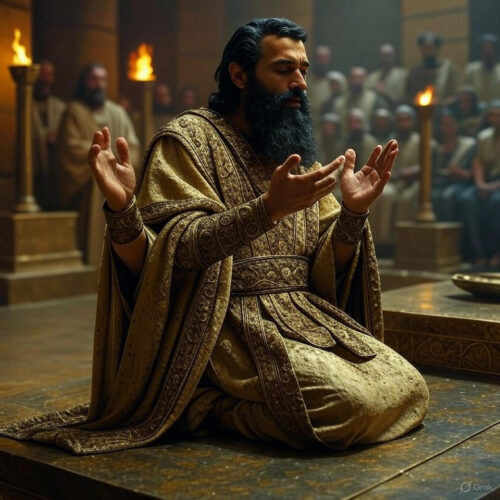
Diving deeper into the historical tapestry, consider the geopolitical chessboard Solomon navigated. Egypt, under Shishak (Sheshonq I), loomed as a southern threat, but Solomon’s marriage to Pharaoh’s daughter sealed a non-aggression pact (1 Kings 3:1). To the north, Hiram’s Tyre was ally gold—Phoenicia’s alphabet influenced Hebrew script, and their shipyards launched joint ventures to Tarshish for silver and monkeys. Edom’s copper mines, reopened under Solomon (1 Kings 7:46), funded the bronze work, with Ezion-Geber as a bustling Red Sea port.
The dedication’s timing? Genius. Tishri’s feasts—Rosh Hashanah (new year trumpet blasts), Yom Kippur (atonement), Sukkot (booths)—layered meaning. Trumpets herald renewal; atonement cleanses; tabernacles recall wilderness wanderings, now upgraded to permanence. The fire from heaven? Echoes Sinai’s thunder, Elijah’s Carmel blaze—a divine endorsement stamp.
Chronicles adds color: 120 priests blast shofars in unison, voices harmonizing psalms of David and Asaph. The cloud’s density halts service, a holy timeout forcing awe. Post-fire, God appears to Solomon nocturnally: “If you walk… I will dwell… but if not, this house becomes a byword” (2 Chronicles 7:12-22). Ominous foreshadowing, yet hopeful hinge.
Economically, the Temple turbocharged Jerusalem. Pilgrimage traffic boomed trade; artisans thrived on commissions for replicas—mini-Arks for homes, perhaps. Socially, it knit tribes: northerners trek south, sharing stories around feast fires. Women? Though not entering the sanctuary, they participate in outer court joys, as later Mishnah notes.
Fast-forward through history’s sieve. Exilic prophets like Ezekiel envision a restored temple (ch. 40-48), fueling hope. Post-exile, Ezra’s altar relaunch in Tishri mirrors Solomon’s (Ezra 3). Jesus cleanses Herod’s version, calling it “my Father’s house” (John 2:16). Early Christians see believers as living stones (1 Peter 2:5).
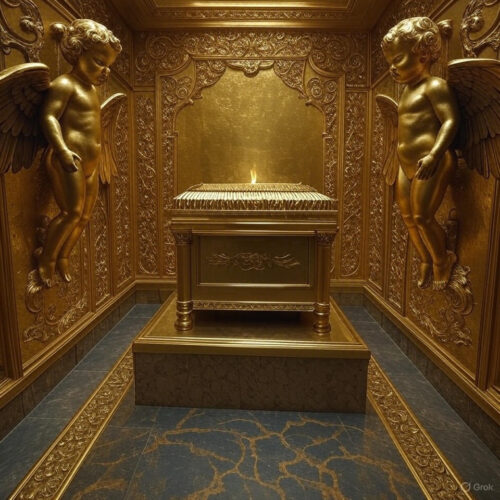
Archaeological whispers: Tell Dan Stele mentions “House of David,” validating dynasty. Ophel excavations yield Iron IIa pottery, timestamping Solomonic era. No Temple remnants—levelled thrice—but the Western Wall’s stones, quarried nearby, carry the vibe.
Culturally, the dedication inspires art: Rembrandt’s sketches, Handel’s oratorios. In literature, from Milton’s epics to modern novels like “The Source” by Michener. It’s a motif of hubris and humility—build big, but bow bigger.
Back to you: That fire? It’s your inner catalyst. When life’s altars pile high with offerings (efforts unrealized), invite the blaze. The plan above? Iterate it quarterly, like seasonal feasts. Track in a “Temple Journal”: wins, wisdoms, wonders.
More history: Solomon’s later years darken—idolatry creeps via foreign wives (1 Kings 11:1-8). High places to Ashtoreth, Milcom dot hills. God raises adversaries: Hadad the Edomite, Rezon of Damascus, Jeroboam the upstart. The kingdom fractures post-Solomon, but the Temple endures as unifying symbol—until northern Israel’s fall in 722 BCE scatters tribes.
Yet, southern Judah clings. Hezekiah’s reforms (2 Kings 18) purify it; Josiah’s rediscovered scroll (2 Kings 22) sparks revival. Babylonian Nebuchadnezzar sacks it in 586, looting gold, torching wood—a 450-year run ends in ash.
Rebirth: Cyrus’s 539 BCE edict frees exiles (Ezra 1). Zerubbabel’s temple, dedicated 516 BCE, lacks Solomon’s splendor—no ark (lost?), no fire—but echoes the rite. Herod’s expansion? A 46 BCE-64 CE behemoth, 35 acres, gold so bright pilots navigated by it.
Destruction redux: Titus’s legions breach walls, Romans melt gold from stones. Today, Al-Aqsa and Dome occupy the Mount, but Jewish prayers face it, awaiting Messiah’s house.
This cycle? Teaches resilience. Temples fall; spirit rebuilds. Your life? Same—setbacks raze, but vision reconstructs.
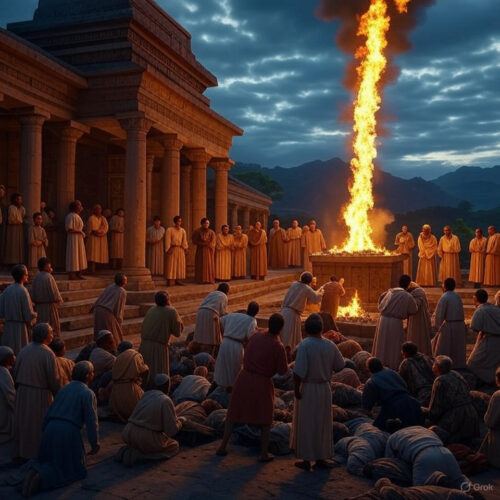
Motivationally, the dedication screams: Scale matches surrender. Solomon’s 23-ton gold? Your gold-standard effort. The cloud? Clarity in chaos. Fire? Fulfillment’s fury.
Expand the bullets:
– **Feast-Lock Your Milestones**: Post-“dedication,” Solomon partied 14 days. After big wins, host a Sukkot-style gathering—booth of gratitude, share stories. Bonds deepen, momentum multiplies.
– **Foreigner-Welcome Protocol**: Solomon’s prayer for outsiders? Audit your circle: Invite one “stranger” (new colleague, neighbor) to your table monthly. Perspectives enrich, networks expand.
– **Byword-Avoid Audit**: God’s warning? Quarterly self-check: Am I walking in wisdom? Adjust altars—ditch draining habits, stoke sacred ones.
– **Glory-Maintain Routine**: Priests oiled lamps daily. Yours? Evening ritual: Review day’s “light”—acts of service—refuel for tomorrow.
– **Eternal Love Echo**: The chant? Internalize it. When doubts drone, hum “His love endures”—a sonic shield for stormy Septembers.
Plan extension: Months 2-7 mirror build phases. Month 2: Source materials (learn skills). Month 3: Frame structure (set boundaries). … Month 7: Dedicate with fanfare.
History’s gift: Proof that one September day can redefine eras. Yours awaits.

To wrap this epic: The dedication wasn’t end; it was ignition. Solomon’s Temple stood as beacon, battleground, birthplace of faith’s fire. Through conquests, captivities, it’s legacy? God’s not confined to houses—He’s in hearts that dare build.

